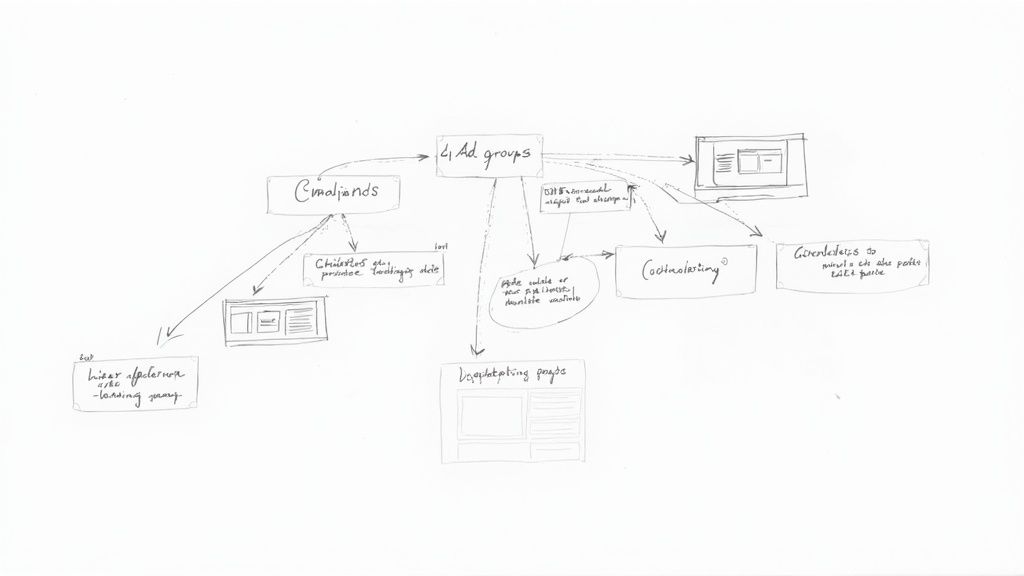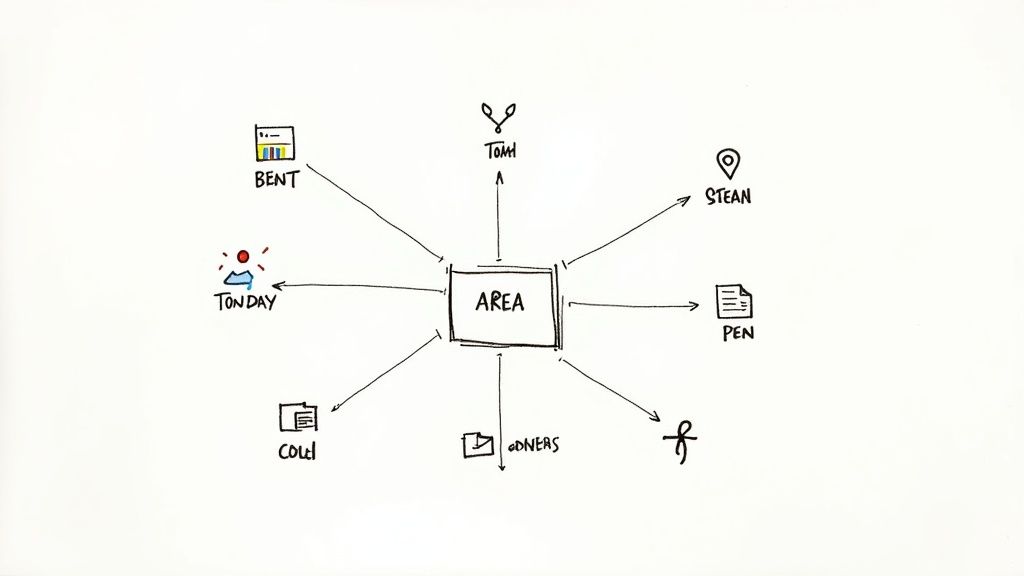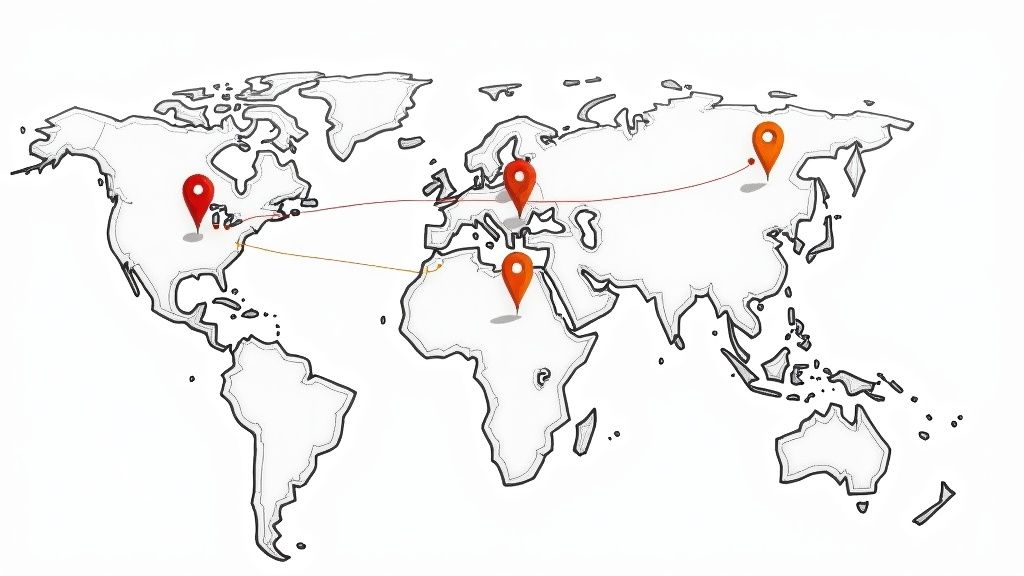At its core, a location landing page is a webpage created specifically to attract customers from a single, defined geographic area. When used with Google Ads, these pages become the perfect destination for someone who clicks a location-targeted ad. The entire goal is to maintain a consistent, hyper-relevant message from the ad a user sees to the specific page they land on, maximizing your ad spend.
The Role of Location Landing Pages in Google Ads
Let's use an example. Say you're a plumber running Google Ads. A frantic homeowner in Brooklyn searches for "emergency plumber Brooklyn" and clicks on your ad.
What happens if they land on your generic homepage? It probably lists every service you offer across the entire state. The connection feels weak. The homeowner now has to dig around just to confirm you actually serve their neighborhood, and they might just give up and leave. This is a wasted click and wasted ad spend.
Now, imagine a different scenario. They click the ad and land on a page titled "Your Trusted Emergency Plumber in Brooklyn." The page immediately shows a local phone number, testimonials from other Brooklyn clients, and maybe even a photo of your van parked by a familiar landmark. The user instantly knows they're in the right place. That’s the magic of a location landing page—it closes the gap between a local search and a high-quality lead from your Google Ads campaign.
This diagram breaks down the main benefits you'll see when you start using location-specific landing pages in your Google Ads strategy.
The best part? These benefits all work together, creating a positive feedback loop that makes your ad spend more efficient and effective.
Why Generic Pages Fail in Local Campaigns
Sending traffic from local ads to a generic, one-size-fits-all homepage is one of the most common—and expensive—mistakes advertisers make in Google Ads. These general pages often have a sky-high "bounce rate" because they don't instantly reassure the visitor that you can solve their local problem.
This mismatch between the ad's local promise and the landing page's broad content sends a clear signal to Google: your page isn't the best answer for that user's search.
When users bounce, it tells Google the landing page experience is poor. This can hurt your Quality Score, which in turn leads to higher ad costs and your ads showing up less often.
Boosting Your Google Ads Quality Score
Google Ads is all about rewarding advertisers who give users a great experience. A huge piece of that puzzle is your landing page experience, which is a major factor in your Quality Score.
Here’s how it works:
- Relevance is Rewarded: When your ad text (like "Plumbing Services in Brooklyn") lines up perfectly with the content on your landing page, Google’s algorithm loves it. This is a sign of high relevance.
- Lower Costs, Better Placement: High relevance boosts your Quality Score. A better score means you can win higher ad rankings without having to pay as much for each click. Your cost-per-click (CPC) goes down, and your budget stretches further.
In the end, location landing pages aren't just a "nice-to-have." They are a core component of making any local Google Ads campaign profitable and successful.
Anatomy of a High-Converting Local Landing Page

Think of your location landing page as your business's local welcome mat for your paid traffic. It’s the very first impression you make when someone clicks your Google Ad, and its job is to immediately reassure them they've come to the right place.
This isn’t about just swapping out a city name on a generic template. It's about crafting a page that screams, "We are right here in your neighborhood, and we understand your specific needs." Every single element has to work together to turn that initial click into a real, qualified lead.
It all starts with a powerful, location-specific headline. If someone searches for "Denver roof repair," they need to land on a page that instantly mirrors that query. A headline like "Your Trusted Partner for Roof Repair in Denver, CO" does exactly that. It’s direct, it’s relevant, and it builds immediate confidence.
From there, the rest of the page needs to deliver on that local promise. Weave in references to local neighborhoods, landmarks, or even common problems unique to the area (like hail damage in Colorado). This shows you’re not just a national chain with a pin on a map, but a true local expert.
Building Trust with Must-Have Components
To really make your page a local conversion powerhouse, you need to include a few key trust-building elements. These aren't just nice-to-haves; they are the essential ingredients for any location landing pages designed to perform well with Google Ads.
Let's break down the essential components you'll want to include on your page and why they matter so much for your ad campaigns.
Essential Elements for Your Location Landing Page
| Component | Description | Impact on Google Ads |
|---|---|---|
| Consistent NAP | Your business Name, Address, and Phone number displayed clearly and matching your Google Business Profile exactly. | Boosts your Ad Rank by signaling local relevance and credibility to Google, which can lead to a lower Cost Per Click (CPC). |
| Embedded Google Map | An interactive map showing your physical location, not just a static image or a listed address. | Visually confirms your proximity to the user, increasing their trust and making it more likely they will convert from your ad. |
| Local Testimonials | Reviews and quotes from customers who live in the same city or neighborhood. | Provides powerful social proof. A review from "Sarah in Highland Park" is far more convincing to a Denver searcher than a generic one. |
| Photos of Your Team | Genuine photos of your local office, storefront, or the team members who serve that area. | Humanizes your business, making you feel like a neighbor rather than a faceless corporation, which can improve ad click-through rates. |
Each of these pieces works together to eliminate any doubt in the visitor's mind. They prove you're a real, local, and trustworthy choice for what they need.
Optimizing the Page for Google Ads Success
Beyond just the content on the page, a little technical fine-tuning is crucial for getting the most out of your ad budget. Start with the page's title tag—that’s the text you see in the browser tab. It's a surprisingly important piece of the puzzle.
In fact, a whopping 78% of top-performing landing pages include the location right in the title tag. On top of that, 55% of these pages also feature the business name, which helps build brand recognition while confirming your geographic relevance.
Finally, your call-to-action (CTA) needs to be impossible to miss. Use clear, action-oriented language that feels local, like "Get Your Free Denver Quote Today" or "Call Our Local Team Now."
For any service-based business, having a clickable phone number is an absolute must. You can even see which pages are driving the most calls by using a dedicated system, which we cover in our guide on call tracking for PPC campaigns. This gives you undeniable proof of what’s working.
Structuring Google Ads Campaigns for Local Success

Having a killer location landing page is a huge step forward, but it’s only half the job. You’ve built the perfect destination; now you need to make sure the right people find it. This is where your Google Ads structure comes in.
Think of it this way: your ads are the delivery trucks, and your landing pages are the specific street addresses. Your goal is to send the right truck to the right address, every single time.
When someone in Austin searches for what you do, they need to see an ad that feels like it was written just for them. That ad should then take them to a page all about your services in Austin. Getting this alignment right is the key to boosting conversions and lowering your ad spend. It all starts with organizing your campaigns by geography, not just by service.
Building Hyper-Focused Ad Groups by Location
The best way to wrangle your local ads is to give each location its own dedicated ad group. Let’s say you’re a roofer with service areas in Dallas, Fort Worth, and Plano. In this case, you'd create a separate ad group for each city.
Why go to all that trouble? Because it gives you incredible control.
Inside your "Dallas Roofing" ad group, for example, your keywords would all be Dallas-centric (think "roof repair Dallas" or "emergency roofer in Dallas"). The ads themselves would mention Dallas, and—most importantly—they would send searchers directly to your Dallas location landing page.
This super-specific approach pays off in a few big ways:
- Sky-High Relevance: Your ads directly answer the user's local search. It's a perfect match.
- Custom Ad Copy: You can get creative and mention things only a Dallas local would know, like a neighborhood-specific offer or a local landmark.
- Smarter Budgeting: See that Dallas is bringing in the most business? You can easily shift more of your budget there.
When your ad group structure perfectly mirrors your landing pages, you create a powerful, unbroken chain of relevance. Google loves this. It's a massive signal for your Quality Score, which directly impacts your ad rank and how much you pay for each click.
Crafting Ad Copy That Mirrors Your Page
With your location-based ad groups set up, it’s time to write the ads. The number one rule is that your ad copy must make a promise that your landing page keeps.
If your Dallas page shouts about "24/7 Emergency Service," then your Dallas ad needs to highlight that exact phrase. This simple consistency builds trust instantly. It tells the user, "Yep, you're in the right place," which keeps them from bouncing off your site and heading to a competitor.
Don't forget that local intent is exploding. Searches including "near me" have shot up by over 900% in the past few years. People are actively searching for businesses right in their backyard. Your ad copy and location landing pages are the one-two punch that meets this demand, making your entire Google Ads account more efficient and profitable.
How to Scale Your Local Landing Page Strategy

If your business serves more than one city or neighborhood, a single location landing page is only scratching the surface. The real magic happens when you scale your efforts by building out a whole network of pages, with each one targeting a specific service area. This is how you turn your website into a local lead-generation machine for your Google Ads campaigns.
The biggest hurdle most people face is figuring out how to create all these pages without Google flagging them for duplicate content. It’s a valid concern, but with the right workflow, it's not something you need to worry about. The secret isn't to write every single page from scratch—that would take forever. Instead, you use a smart template.
Think of it like building with LEGOs. You create a master template with all your core branding, service descriptions, and layout. Then, for each new city or neighborhood, you just swap out a few specific "blocks" with unique, local details. This keeps your branding consistent while making every page feel distinct and genuinely helpful to local searchers.
Avoiding the Duplicate Content Trap
Let's clear something up: Google doesn't punish you for pages that are similar. It punishes pages that offer no unique value. Your goal is simply to make each page useful for someone in that specific area.
So, how do you add that unique local flavor?
- Local Case Studies: Feature a project you knocked out of the park in that city.
- Neighborhood-Specific Offers: Got a special deal just for folks in a certain ZIP code? Mention it.
- Team Photos: Show pictures of the actual team members who work in that location.
- Local Testimonials: Pull quotes from happy customers right in that neighborhood.
This isn’t just about dodging a penalty. It’s about building real trust and showing potential customers that you understand their community.
The more you scale your localized content, the more opportunities you create to capture leads. It's a numbers game where quality and quantity can work together.
And the numbers don't lie. Companies that build 31 to 40 landing pages generate seven times more leads than businesses with just one to five pages. Even a modest increase pays off—businesses with 10-15 landing pages see a 55% jump in new customers compared to those with fewer than ten.
Technical Steps for Successful Scaling
To make sure all this hard work pays off, you need to get the technical side right. It all starts with a clean, logical URL structure. A simple format like yourwebsite.com/locations/city-name works wonders for keeping things organized for both people and search engine crawlers.
Embedding a unique map on each page is also a must. If you're managing a ton of different service areas, learning about adding multiple locations to Google Maps is a skill that will pay dividends.
Finally, make sure every new page gets added to your XML sitemap. This tells Google exactly where to find all of your valuable location landing pages, ensuring they get crawled and indexed properly.
Using Video to Boost Landing Page Engagement
When you're fighting for attention in a crowded local market, your location landing pages have to do more than just list facts. They need to create a real connection. While text and images are essential, nothing grabs attention and builds instant trust quite like video.
Think about it from your customer's shoes. Reading a description of your storefront is fine, but a quick 30-second video tour makes your business feel tangible and welcoming. This kind of dynamic content cuts through the digital clutter and makes your local spot far more memorable.
Simple Video Ideas That Build Trust
You don't need a Hollywood-sized production budget to make great videos. In fact, simple and authentic content often works best because it feels more genuine to a local audience.
Here are a few powerful video ideas you can shoot with just your phone:
- A Quick Office Tour: Just walk people through your local shop or office. It’s a simple way to offer visual proof that you’re a real, established business right there in their community.
- Heartfelt Client Testimonials: Ask a happy local customer if they'd be willing to say a few words on camera. Hearing praise from a neighbor is incredibly persuasive—much more so than a written review.
- Meet the Local Team: Film short introductions of the team members who work at that location. Putting a face to a name instantly makes your business feel more personal and approachable.
These simple videos don't just grab attention; they keep people on your page longer. This increased "dwell time" sends a strong signal to Google that your page is delivering value, which can give your search performance a nice little bump.
The Impact of Video on Conversions
Adding a video isn't just a cosmetic touch; it's a smart business move that can directly boost your results. According to industry research, landing pages with video can see an 86% increase in conversions. Video builds a level of trust and engagement that’s perfect for a location page trying to showcase its physical space or local expertise.
Embedding a video is easy, but you have to do it right to avoid slowing down your site. The best approach is to host your video on a platform like YouTube or Vimeo and then embed it on your page. This keeps your page loading fast, which protects your user experience and your Google Ads Quality Score. To dive deeper, you can learn how to sell more with videos on your landing page and find even more helpful tips.
Got Questions About Location Landing Pages? We've Got Answers.
As you start building a local strategy for Google Ads, you're going to have questions. It's only natural. Getting clear answers is the key to building a campaign that actually works, instead of one that just eats up your ad budget.
Let's walk through some of the most common questions we hear about creating and managing effective location landing pages.
How Many Location Landing Pages Do I Actually Need?
The honest answer? It depends entirely on your business. A good rule of thumb is to start with your most valuable locations—the cities or neighborhoods that are your bread and butter. Create one solid, unique page for each of your physical offices or the main cities you serve.
Once those are up and running, you can think about expanding. There's data showing that businesses with 10-15 landing pages can see a 55% bump in leads. But—and this is a big but—don't chase numbers for the sake of it. The goal is to make sure every single page offers real, local value. Fight the urge to create dozens of flimsy pages for every tiny surrounding town.
Always choose quality over quantity. A few great pages will always outperform a hundred weak ones and will keep you in Google's good graces.
Will I Get Penalized for Duplicate Content?
This is a huge concern for a lot of people, but it’s totally manageable. Google doesn't penalize you for having multiple pages; it penalizes you for having multiple pages that are all the same. If your pages offer no unique value, you're in trouble.
So, how do you make each page truly different? It’s about more than just swapping out the city name in the headline.
- Feature testimonials from actual customers in that specific city.
- Show off photos of your team on a local job or finished projects in that neighborhood.
- Give directions from a well-known local landmark, not just a generic map.
- Highlight special offers or services available only to that area.
It's perfectly fine—and smart—to use a template for your page design and branding. That's just efficient. The magic happens in the details: the words, the photos, and the local proof have to be unique to each community.
What Google Ads Metrics Should I Be Watching?
To figure out if your local campaigns are actually making you money, you need to ignore the vanity metrics and focus on what matters. The big three you should be watching in your Google Ads account are Conversion Rate, Cost Per Conversion (CPA), and Quality Score.
A high conversion rate tells you your message is hitting the mark with the local audience. A low CPA means you're acquiring customers profitably. And a high Quality Score, which is heavily influenced by how relevant your landing page is, will literally save you money by lowering your ad costs and improving your ad's position.
It’s also a good idea to peek at Google Analytics and check out on-page metrics like Bounce Rate and Time on Page. A high bounce rate is a huge red flag; it usually means your ad promised one thing and your landing page delivered something else.
How Can I Track Phone Calls from Different Locations?
For any local business, knowing where your calls are coming from is a must. The best way to do this is to give each of your location landing pages its own unique, trackable phone number. It’s the only way to get crystal-clear data on which pages are making the phone ring.
Google Ads has a feature called Google Forwarding Numbers that can dynamically swap the number on your page for users who clicked an ad. If you want even more robust data, there are fantastic third-party call tracking tools out there.
By using a unique number for each location, you can trace every single phone call back to the exact ad and landing page that produced it. This clarity gives you the power to make smart, data-driven decisions about where to spend your marketing dollars.
Stop losing leads by manually downloading them from Google Ads. Pushmylead instantly forwards lead information from your campaigns directly to your inbox, so you can follow up in seconds. Learn more and get started at https://www.pushmylead.com.
